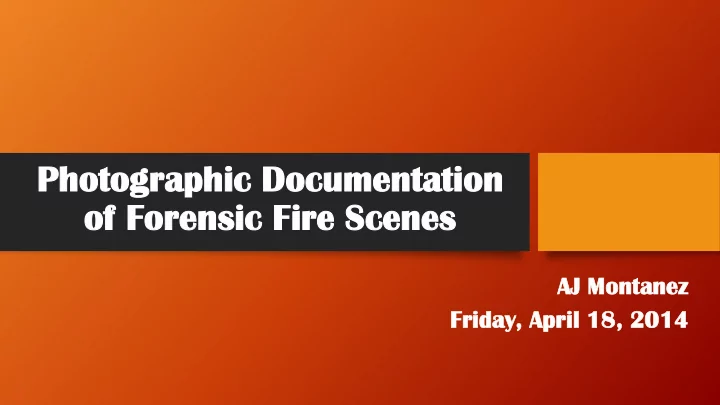

Pho hoto tographi phic c Docum cumentation of Fo Fore rensic c Fi Fire re Scene cenes AJ M Montan tanez Fri riday, Apri ril l 18, 8, 2014
Overview • Fire Patterns • Fire Pattern Analysis • Two-Dimensional Photographic Documentation • Three-Dimensional Photographic Documentation • Future of Fire Pattern Analysis
For Starters… What is Fire? • Fire = “uncontrolled combustion involving chemistry, thermodynamics, fluid mechanics, and heat transfer.”
What are Fire Patterns? • Fire pattern = the visible or measureable physical effects that remain after a fire. • Fire patterns result from: • Smoke • Hot gases • Heat • Flames
The Creation of Fire Patterns • Fire patterns represent demarcation lines of fire effects upon materials created by the 3D shape of the fire plume being cut by an intervening 2D surface. • Wall, ceiling, appliances, furniture, a body, etc.
Iron Man 3
Examples of Fire Patterns: “Classic V”
Examples of Fire Patterns: Protected Surface
Fire Pattern Analysis • Purpose: reconstruct the dynamics of the 3D fire event. • Want to predict fire phenomena and characteristics: • Fire’s origin • Intensity • Growth • Direction of travel • Duration
Basic Methods for Fire Pattern Analysis • Bench-scale modeling • Full-scale modeling • Computer modeling
On-Scene Analysis Tools • Thermocouple trees and heat flux transducers. • Heat and flame vector analysis, depth of calcination. • Video and still photography. • Direct observation. • Written notes and diagrams.
Two-Dimensional Data Capture • Record general features of and the relationships with other objects nearby. • Helpful in determining how the fire spread. • Documentary photographs – mimic rough sketches (qualitative) . • Metric photographs – like engineering drawings or maps (quantitative) . • 35mm film usually better than digital images.
Digital Images • Digital photos or videos – image data is stored in a binary format. • Recording an artifact’s surface geometry and its photometric properties. • Ultimately, allow fire investigator to answer reconstructive questions about the dynamic development of fire patterns.
Problems with 2D Data Capture • In photography, lighting is everything! • Burnt objects are black – absorb light. • High reflectivity of charring. • Low levels of light in indoor scenes. • Photographs and diagrams are often not sufficient to capture information on three-dimensional fire dynamics and building construction.
Review: Purpose of Photographic Reconstruction • Fire investigator wants to answer reconstructive questions about the dynamic development of fire patterns. • Three-dimensional images for a three- dimensional phenomena. • 3-D imaging can add “quantitative content.”
Emerging Three-Dimensional Imaging Technology • Use of photogrammetry and computer vision to create 3D images from photographs and video sequences. • Typically need a matched pair of images from two different vantage points for 3D reconstruction. • Ex: The Italian Job.
3D Imaging Features: Cameras and Scanning Technologies • Laser 3D scanners/cameras: • Capture depth and volume aspects. • Generate digital scene replicas.
How Laser Scanning Works • “Sheet-of-light” technique: laser triangulation and sensors to determine light intensity and height and width profiles. • Combination of hardware and software.
3D Imaging Progression 1. Actual 2. Laser Scan 3. Color Corrected 1 2 3
Newer 3D Scanning Tools • Hand-held scanners: • Use geometric fusion algorithms to generate complete shape scans.
3D Imaging Techniques: + and - • Biggest Pros: • 3D fire analyzed in 3D truer recreation. • Do not have to remove evidence from where it was found in the crime scene! • Biggest Cons: • Very expensive. • Large and cumbersome instrumentation.
Creating Fire Pattern Databases • Pattern recognition: statistical comparison of pattern data against patterns or info extracted from patterns. • Like CODIS, AFIS, and IBIS. • 3D scans will improve fire pattern databases. • Compare known/unknown scans by: • Graphical overlapping. • Geometric transformations.
Current State of Affairs • Currently, fire pattern analysis is quite subjective. • Databases would shift analysis from subjective interpretations to objective conclusions. • Better understanding of fire remains increased reliability of investigator’s conclusions.
The Future of Fire Pattern Analysis • 3D imaging technologies are improving accuracy, precision, variability, and objectivity. • Recognized by NIJ and NIST as the up-and-coming method for fire pattern analysis. • Accessibility and use of 3D scanning will increase as the equipment becomes more affordable. • Overall, will lead to more productive fire investigations by improving quantitative and qualitative analyses.
Acknowledgments • Dr. Pamela Staton • Nadine Borovicka • Miranda Davis • Darcie Winkler • Hannah Kennedy • Jordan Green
References 1. Adams, Barbara, Cynthia Brakhage, Leslie Miller, and Clint Clausing. Fire Investigator: Second Edition . Stillwater, OK: Fire Protection Publications, Oklahoma State University, 2010. Print. 2. Dioso-Villa, Rachel. "Scientific and Legal Developments in Fire and Arson Investigation Expertise in Texas v. Willingham." Minn. JL Sci. & Tech. 14 (2013): 817-951. 3. Hasinoff, Samuel W., and Kiriakos N. Kutulakos. "Photo-consistent reconstruction of semitransparent scenes by density-sheet decomposition." Pattern Analysis and Machine Intelligence , IEEE Transactions on 29.5 (2007): 870-885. 4. International Association of Arson Investigators. Fire Investigator: Principles and Practice to NFPA 921 and 1033 . Jones & Bartlett Publishers, 2012. Print. 5. May, Thomas R. "Fire Pattern Analysis, Junk Science, Old Wives Tales, and Ipse Dixit: Emerging Forensic 3D Imaging Technologies to the Rescue?." (2010). 6. NFPA 921: Guide for Fire & Explosion Investigations: 2011 Edition . Quincy, MA: National Fire Protection Association, 2011. Print.
Image References • http://www.verycoollife.com/how-to-start-a-fire/ • http://media.propertycasualty360.com/propertycasualty360/article/2011/10/26/Technical_Image5_Nov2 011.jpg • http://4.bp.blogspot.com/--7nXNegdaAg/UIbrVYo9jiI/AAAAAAAAFwA/xEhYFKjdaLo/s1600/im3-shadow.jpg • http://www.interfire.org/res_file/patt_v.asp • http://www.interfire.org/res_file/images/body.jpg • http://www.enfp.umd.edu/sites/default/files/images/mat1.png • http://www.nist.gov/el/fire_protection/buildings/images/Cable_Spreading_Room_0534.jpg • http://fc07.deviantart.net/fs71/f/2011/083/a/d/charred_wood___texture_pack_by_dreamofsandman- d3cd0np.jpg • https://encrypted- tbn2.gstatic.com/images?q=tbn:ANd9GcSntlhzfdALKnsEaQt0ZBeOB6h7XSDin2ilMPTYAMXSSWnZPpKsxw
Image References (cont’d) • http://i.dailymail.co.uk/i/pix/2012/05/02/article-0- 12DD6AE8000005DC-894_306x423.jpg • http://www.deskeng.com/pics/0111/Illustr_Triangulation_305.jpg • http://resources3.news.com.au/images/2010/12/24/1225976/006271- 3d-camera.jpg • http://kenswain.3design.info/wp-content/uploads/2011/03/pipe_01.jpg • http://www.gefos.cz/web/en/3d-scanning/ • http://img.directindustry.com/images_di/photo-g/high-resolution-3d- laser-scanners-53579-2838743.jpg • http://media.giphy.com/media/cI6Qfr0bWjDWM/giphy.gif
Any Questions?
Recommend
More recommend